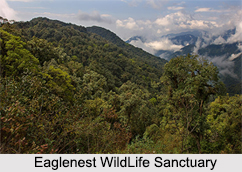 The state of Arunachal Pradesh is located in the north eastern part of India and is regarded as one of India"s seven Sister States. This state has mountains, lakes, museums, Tawang (a town with a Buddhist monastery), Yomcha (limestone caves called `tapen uru`), etc. These, along with the scope for angling, boating, rafting, trekking and hiking draw a number of tourists to this state. Arunachal Pradesh also has wildlife sanctuaries, which are protected areas maintained to provide suitable habitats to the flora and fauna in the state. There are several wildlife sanctuaries, reserves forests and biosphere reserves in the state.
The state of Arunachal Pradesh is located in the north eastern part of India and is regarded as one of India"s seven Sister States. This state has mountains, lakes, museums, Tawang (a town with a Buddhist monastery), Yomcha (limestone caves called `tapen uru`), etc. These, along with the scope for angling, boating, rafting, trekking and hiking draw a number of tourists to this state. Arunachal Pradesh also has wildlife sanctuaries, which are protected areas maintained to provide suitable habitats to the flora and fauna in the state. There are several wildlife sanctuaries, reserves forests and biosphere reserves in the state.
Sanctuaries in Arunachal Pradesh
There are numerous wildlife sanctuaries and reserve forests scattered around the state, which are Talley Valley Wildlife Sanctuary, Itanagar Wildlife Sanctuary and Eaglenest Wildlife Sanctuary, Kamlang Wildlife Sanctuary, Mehao Wildlife Sanctuary, Pakhui Wildlife Sanctuary, Sessa Orchid Sanctuary, Kane Wildlife Sanctuary, Daying Ering Wildlife Sanctuary, Mouling National Park, Namdapha National Park, Sigem-Daporijo Reserve Forest, Kamala Reserve Forest, Namsai Reserve Forest, Piyong Reserve Forest etc. Some of the sanctuaries have been discussed below:
 Kamlang Wildlife Sanctuary: Kamlang Wildlife Sanctuary is located in Lohit district. It was established in the year 1989 and occupies an area of about 783 square kilometers. The flora of this wildlife sanctuary comprises of Alpine vegetation, tropical wet evergreen forests, 150 tree species, 49 species of orchids, herbs, bamboos, grasses and shrubs. Its faunal population comprises of about 61 species of mammals, 105 bird species and 20 species of reptiles.
Kamlang Wildlife Sanctuary: Kamlang Wildlife Sanctuary is located in Lohit district. It was established in the year 1989 and occupies an area of about 783 square kilometers. The flora of this wildlife sanctuary comprises of Alpine vegetation, tropical wet evergreen forests, 150 tree species, 49 species of orchids, herbs, bamboos, grasses and shrubs. Its faunal population comprises of about 61 species of mammals, 105 bird species and 20 species of reptiles.
Mehao Wildlife Sanctuary: Mehao Wildlife Sanctuary is located in the Lower Dibang Valley district. It is spread over an area of about 282 square kilometers and was established in the year 1980. Tropical evergreen forests, sub-tropical and temperate forests, temperate broadleaf forest, temperate coniferous forest, trees, shrub and herb species comprise the flora of this wildlife sanctuary. This wildlife sanctuary also provides shelter to several mammals, birds, snakes and fish species.
Pakhui Wildlife Sanctuary: Pakhui Wildlife Sanctuary is located in the foothills of the Eastern Himalaya in the East Kameng District. It was declared a sanctuary in the year 1977 and was declared a tiger reserve in the year 2002. Lowland semi-evergreen, evergreen forest, Eastern Himalayan broadleaf forests, woody species of flowering plants, etc consist of the flora of this sanctuary. Elephants, barking deer, sambhars, monkeys, tigers, leopards, etc comprise the fauna of this sanctuary.
 Sessa Orchid Sanctuary: Sessa Orchid Sanctuary is located in the Himalayan foothills in Bhalukpong Forest Division of West Kameng district. It was established in the year 1989 and occupies an area of about 100 square kilometers. More than 200 orchid species with 5 new and endemic species are the noteworthy aspects of this sanctuary.
Sessa Orchid Sanctuary: Sessa Orchid Sanctuary is located in the Himalayan foothills in Bhalukpong Forest Division of West Kameng district. It was established in the year 1989 and occupies an area of about 100 square kilometers. More than 200 orchid species with 5 new and endemic species are the noteworthy aspects of this sanctuary.
Kane Wildlife Sanctuary: Kane Wildlife Sanctuary is situated in the district of West Siang and is spread over an area of about 55 square kilometers. This sanctuary provides suitable habitat to elephant, small cats, deer etc.
Namdapha National Park: Located near the border of Myanmar, Namdapha National Park is the most unusual and most significant wildlife sanctuaries of India. It is the abode of a wide range of endangered species of flora and fauna and avian life. It is the 15th Tiger Reserve in the country and spread over an area of about 1985 sq. km. It provides habitat to tiger, leopard, clouded leopard, snow leopard, takin, hoolock gibbon, red panda, capped langur etc.











